American babies consume an average of 600 jars of baby food by the time they are a year old (Chasing Green 2011). Four out of five British babies rely on tinned and jarred products (Rees 2007). Yet, the U.S. Government lists the vast majority of commercial baby food as “not creditable infant foods” on its WIC program (2011), and the U.K. Government maintains that, “Home cooking should always be encouraged over using commercial baby foods” (Infant and Child Feeding Guidelines 2010).
In a triumph of marketing over corporate responsibility, baby food companies, including the so-called ‘organic’ brands, sabotage the health of babies in their quest for profits – and parents facilitate it. Here’s how:
THE COST:
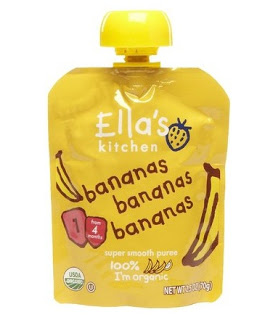
The global baby food market is worth more than £6 billion. Baby food manufacturers have found a goldmine in gullible parents. When parents buy commercial baby food they are paying, not only for all the ingredients, but also for the processing, packaging, storage, transportation, advertising and marketing. Consequently, commercial baby foods are very highly priced compared to similar regular foods.
Let’s take bananas for example. A pouch of “Ella’s Kitchen Bananas” costs 69p (about $1.09). An organic fair-trade banana costs 23p (about 35 cents). You’d need to buy six and a half commercial pouches to equal one pound of bananas (source: tesco.com). This is an example of commercial baby food featuring one ingredient: bananas. The cost escalates further when other ingredients are included. Commercial baby foods featuring several ingredients can cost as much as £1 per jar, particularly if you’re going organic, meaning you can spend around £5 a day, if you’re using them for breakfast and pudding too. That’s £35 a week, £140 a month and £840 from six months until your baby’s first birthday. Annabel Karmel and her shareholders are laughing their way to the bank. Her Organic Baby Purees cost a staggering £1.49 ($2.34) per pouch! (To add further insult to parents, the largest ingredient is water – yup, bog standard tap water).
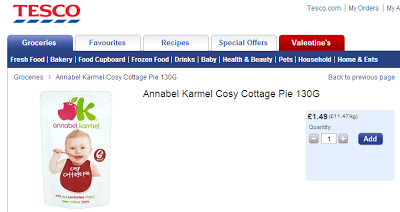
At first blush, £1 for a jar or pouch of baby food doesn’t seem like much, but as your baby grows, he or she will eat more solid food at each feeding. The baby food jars get bigger and up to three times more expensive. Remember the statistic I quoted above? – By the time U.S. infants reach 12 months of age, they’ve consumed about 600 jars of baby food. That’s a minimum cost of $300. By comparison, you can prepare a wide variety of fresh baby food at home for around $55 total (Tallman and Ahlers 2013). The numbers speak for themselves.
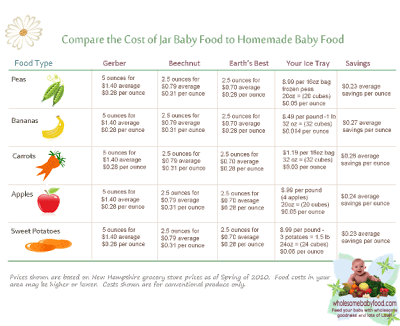
THE BULKING:
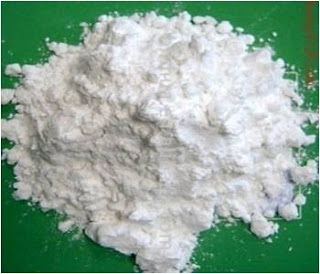
Numbers (aka profits) are the most important consideration in the eyes of baby food manufacturers. Consequently, the pictures of fresh produce adorning jars don’t tell you the whole story of what’s inside. To cut costs manufacturers replace real food with water and thickening agents/starches. Most often, the starches are refined rice, refined corn and refined wheat. These substances are devoid of the outer layers of the grain, with preservatives and bleach commonly added during processing. The refining of any grain reduces its vitamins, proteins and roughage (Spock 2004). What’s more, refined starches play a significant role in causing dental caries, as they form a sticky paste around the teeth.
Bulking food in this way dilutes its nutrient density (bad for baby) whilst adding volume (good for manufacturers). This means the company can sell what is basically water along with a small amount of poor quality supermarket-rejected vegetables. For instance, check out this jar of Cow & Gate ‘Pureed Carrot, Potato and Lamb Hotpot’ (found stocked on a major UK supermarket shelf, January 2013). The largest ingredient is water. Then there are some ‘baby-grade’ vegetables (more on these below) and also ‘millet flour’ and ‘wheat starch’. The use of these starchy thickening agents adds no nutritional value whilst masking the fact that the majority of the product you’re paying for is water. As any cook knows, a little bit of flour or starch can thicken a lot of liquid.
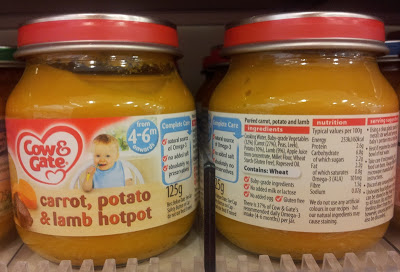
Here’s a jar of Cow & Gate “Sweet Potato and Beef”. Again, the largest ingredient is water, along with the thickening agents cornflour and Tapioca Starch, and another EIGHT ingredients that weren’t mentioned on the front!
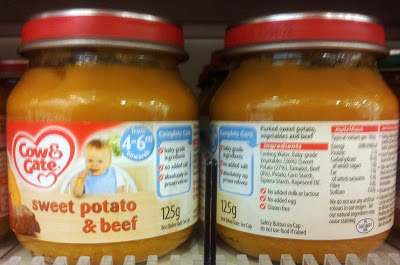
It’s not just Cow & Gate that use bulking techniques. This jar of Heinz “Cheesy Tomato Pasta Stars” has water as the largest ingredient, along with the thickening agent cornflour.
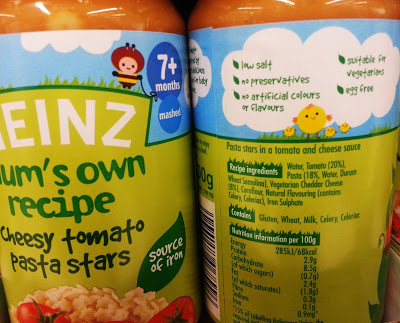
Heinz apply the same water and cornflour combo in their “Spaghetti Bolognaise”:
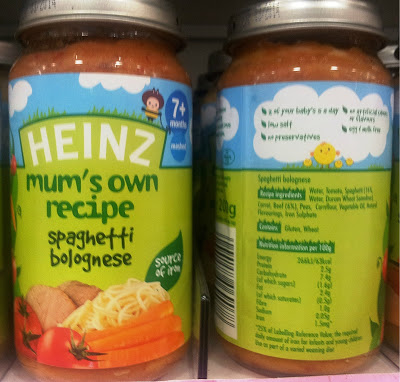
And again in their “Banana yogurt” – water is the largest ingredient, and cornflour and rice starch are used as thickening agents. Interestingly, banana accounts for only 20% of the product, and there is a lot of added sugar (again, not mentioned on the front).
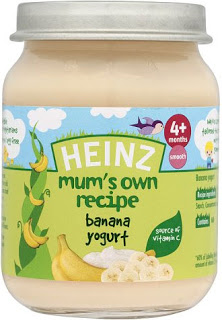
Heinz “Cheesy Pasta with Ham” is the same story. Water is the largest ingredient and cornflour is used as a thickener. Noticeably it contains only 5% ham (some of which is starch and salt!) This product is nothing more than a cocktail of empty calories in the form of starches and processed fat devoid of essential fatty acids.
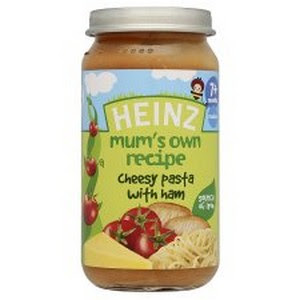
These are just some examples. The list goes on.
When we do the math, we can see why manufacturers do this: The maximum amount of starch required to thicken a 4-ounce jar of food is 0.3 ounces, which costs about 1 cent per jar. By contrast, to replace the water and starch in a 4-ounce jar with carrots, for instance, would require an additional two ounces of carrots, at a cost of 7 to 10 cents. In this instance, doing what’s best for babies would mean sacrificing profits.

Aside from diluting the nutrition content and reducing value for money, another problem with bulking is that several of the most common fillers are potential allergens. Most of baby food jars for example, contain significant amounts of gluten. The fact that many of these jars have “suitable from 4 months” on the label is even more worrisome. Corn and Wheat can both potentially cause allergic reactions in babies and small children, and some recent scientific studies suggest that long term allergies, such as the allergy to wheat (Celiac disease), may be reduced by avoiding contact with those foods before babies are one year old (Erin 2009). So by feeding their babies commercially prepared baby foods loaded with fillers, parents may be inadvertently exposing their infants to large quantities of potential allergens.
Furthermore, with all this bulking going on, there isn’t much room left for credible ingredients. The bulking agents (carbohydrates) are replacing proteins and fats which are essential for adequate health and growth. A baby’s growing muscles, bones, brain, and all other structures are built from the protein and fat he consumes.
For example, if we look back at the jar of Heinz “Cheesy Pasta with Ham”, we notice that it contains only 5 percent ham. Parents purchasing such ‘complete meals’ will be forgiven for assuming them to be a good source of protein, after all, a protein is listed prominently on the jar’s main title (‘ham’). However these dinners are a very poor source of protein given the small percentage of meat/meat alternate required to be in them.
On the topic of requirements, manufacturers tread right on the edge of the law in order to maximise profits. For instance, EU legislation states that if a protein is named first in the title of the product – as, for example, in “chicken and vegetable dinner” – the protein must make up at least 10 percent of the product. So if we look at Cow & Gate’s “Chicken Sunday Lunch” pictured below, we see that just 10 percent is chicken, the bare minimum required by law. Also notice the massive chicken adorning the lid of the jar – misleading.
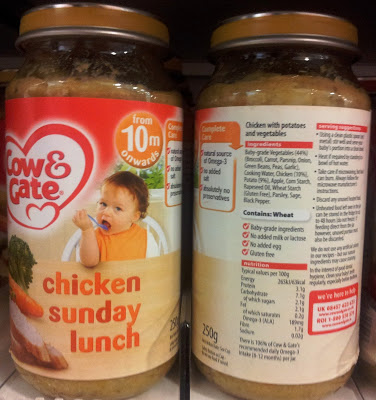
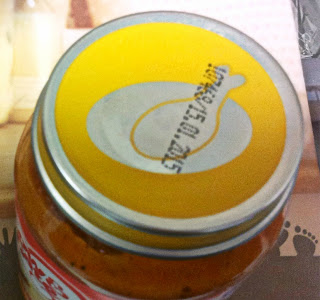
Even more misleading is their “Beef Casserole”. “Beef” is named first, yet the beef content is only 8 percent! This is below the legal limit. The lid of the jar is decorated with a massive beef joint.
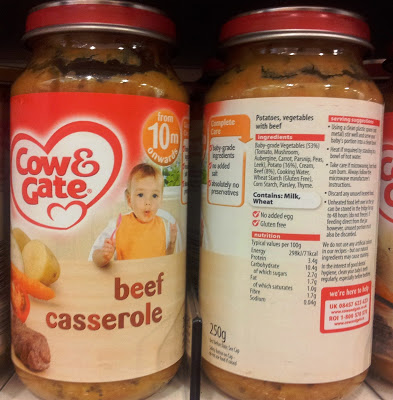
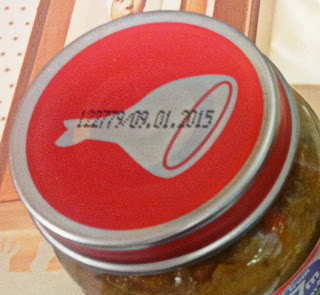
Heinz “Fruity Chicken Casserole” was blasted by consumer watchdogs back in 2006 because it contains only 8% chicken despite arguably having chicken named first (see the news article here). Yet seven years later the jars remain unchanged and Heinz continue to stock them in stores.
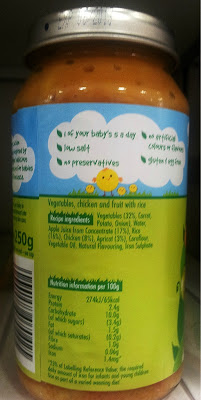
Heinz “Chicken and Parsnip Bake” features “Chicken” named first on the title, yet the chicken content is only 8 percent!
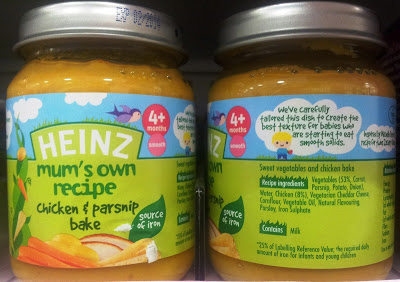
Legislation also states that if a protein is the only ingredient in the product’s name, then legally at least 40 per cent of the food should be that protein. Here’s where the manufacturers get even sneakier. Cow & Gate’s “Orchard Chicken” contains only 10 percent chicken. Presumably they would argue that “Orchard” is another ingredient – apple maybe? But the apple content is even less at only 8 percent!
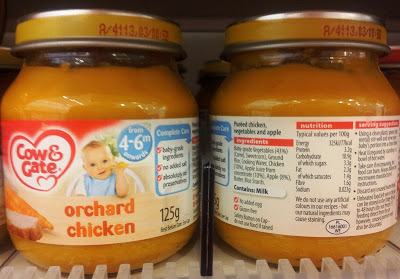
Cow & Gate’s “Yummy Harvest Chicken” contains, yup you guessed it, just 10 percent chicken. Presumably “yummy harvest” is another ingredient but this is far from clear.
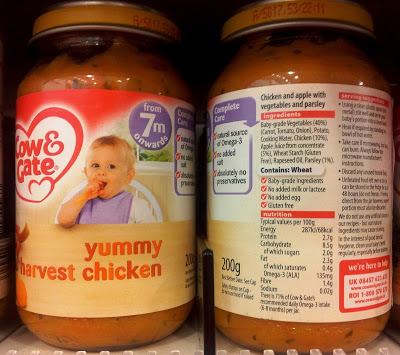
THE NUTRIENTS (lack of):
As bulking dilutes the nutrient density of foods, the contents of this next topic should come as no surprise.
Recent research has confirmed the fears of lazy parents – that commercial baby food contains hardly any nutrients. Many of the most popular brands contain less than a fifth of a baby’s recommended daily supply of calcium, magnesium, zinc, iron and other crucial minerals (University of Greenwich 2012). If a baby consumed one meat jar, one vegetable jar and 600ml of formula milk it still would not be enough calcium, magnesium, copper and selenium. The levels of these three together are less than 20% of the recommended daily supply. Thus, babies fed solely on store-bought jars and formula milk are being deprived of nutrients crucial for growth, development and to protect against illness.
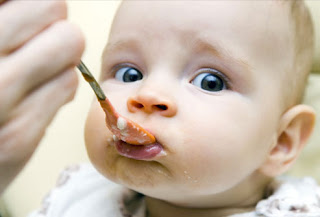
In fact, using processed baby food is akin to feeding your baby junk food for every meal. You wouldn’t feed your baby a Big Mac would you? Well that’s exactly what parents are doing when feeding their baby some of the most popular brands on the market. Research has proven that some of the main brands, including Heinz and Cow & Gate, are less nutritious than a cheeseburger! (The Guardian 2009). What’s more, eating this sub-standard nutrition is more damaging to babies than to adults. That’s because babies don’t need many calories, but they do need lots of nutrients. It’s easy for them to fill up quickly on junk food’s empty calories.
And it gets worse. Ever wondered how a jar of baby food can be older than the baby itself – and still remain nutritious? Answer: it can’t. The priority of baby food manufacturers is not your baby’s health, rather their main concern is profits. This is basic company law. “The purpose of a company is to generate profits for its shareholders” (Companies Act 2006). The longer a product can remain on the store shelves, the more chance it has of being purchased, and the lower the costs for the manufacturer and the retailer (less restocking, more bulk batches, cheaper wholesale purchase of ingredients). Consequently manufacturers have made it so their baby food products have a very long shelf-life (up to several years in some cases!)
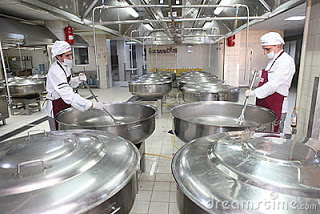
So how do baby food manufacturers achieve this malicious lifespan when a tub of homemade food can only stay edible for a few weeks when frozen? The answer is in the preparation. In order to remain edible for so long the product must be heated to a very high temperature for a sustained length of time so that chronic bacteria are killed. However whilst this process destroys most of the contaminating micro-organisms, the few that are left multiply faster because the resistance of the food to bacteria and moulds is lowered by the heating process. The heating process also destroys naturally occurring commensal or ‘friendly’ micro-organisms. The reduced populations cannot build up quickly enough afterwards to counter the spread of the ‘baddies’.

Moreover during this process most of the beneficial nutrients are also killed. So even if the jar states “organic”, the nutrative value is not even close to non-organic food that you would prepare yourself at home. This is why so many commercial baby foods are ‘fortified’. The food has been cooked to death – literally! So the manufacturer has to add synthetic vitamins and minerals to get the food value back up. This provides an illusion of meeting benchmark standards.
But vitamins are vitamins right? It doesn’t matter whether they’re inherent in the food itself or added afterwards. Wrong! The problem with synthetic vitamins is that they are not as bioavailable as naturally occurring vitamins. In other words, they are less easily absorbed by your baby’s body. Also, many of the nutrients and vitamins counteract each other, therefore not doing any good (International Baby Food Action Network 2012).
THE QUALITY (lack of):
Increasing shelf life by bulking foods is just one of the tactics used by manufacturers to maximise profits. They are also prepared to sacrifice the quality of even their non-bulking ingredients. For instance, if you look at a lot of commercial baby food, the label will say ‘baby grade’ veg/fruit etc. This means that although it is ‘real’ fruit/veg (and may well be organic if stated on the jar), it’s pretty much the poorer quality damaged and malformed ‘scraps’ that don’t make it onto the supermarket shelves. These scraps are then boiled to death and pureed to disguise their inherent imperfection.
As an illustration, take a look at the photo below. On the left are home-made green beans. On the right are jarred baby food green beans. Both only have 2 ingredients – green beans and water.
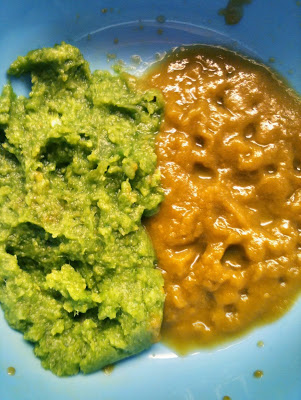
You see, commercial baby foods are designed to be homogenised in taste and texture. One particular brand of green bean puree will always taste the same. However, if you make your own green bean puree, the variety of the bean, the amount of water added and the extent to which it is mashed will vary each time. This variation gives babies an important lesson in the tastes of food; small variations are acceptable.
Variation is imperative when we consider that research shows there is a window of opportunity for introducing tastes and textures to young infants, before the age of 12 months. During that precious first year, “it takes an average of 6 to 10 exposures for 85% of babies to imprint on a flavour and texture” (Green 2010). After 12 months, infants become much more difficult to feed, and often become wary of new foods. So it is important they are given foods that vary in taste and texture, and ultimately represent the foods that the family eat (Coulthard 2011). Studies have also shown that if babies consume commercial baby food before 24 months, they are likely to acquire a lower IQ (Smithers et al 2012). This is because diet supplies the nutrients needed for the development of brain tissues most actively in the first two years of life.
As the quality is so poor, the taste of commercial baby foods falls way below the standard that adults would accept (try some yourself). I often question the integrity of adults who reject substandard food for themselves yet happily feed it to their infants.
In an attempt to hide the poor quality of their product and salvage some of the taste, the manufacturer adds extra ingredients. Ironically, this practice reduces the quality further. At best, these extra ingredients are nutritionally empty, and at worst, they are nutritionally dangerous, particularly when consumed by infants. For instance, many commercial baby foods (including organic brands), are high in sodium, sugar, or both (Bennett et al 2012; Chait 2010; Children’s Food Campaign 2009). Every calorie taken up by these ingredients is a lost opportunity for baby to eat a nutrient rich food that will facilitate proper growth and development. What’s more, the implications can last a lifetime. Take, for example, extra salt; Children can develop a liking for excessively salty foods in infancy, leading them to perceive unsalted foods as being flavourless (The Food Commission 2000).
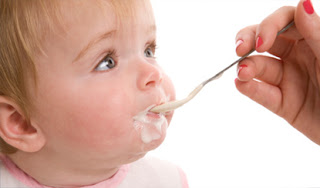
Ironically, when comparing commercial baby foods to similar adult versions, they don’t prove healthier, and are sometimes even worse. In one study, baby yogurts, for example, contained about 63 mg of sodium, while the adult sample only contained 50 mg (Giovinazzo 2010). Another study revealed the same conclusion (Journal of Public Health 2010). Again, this is a case of adults giving babies the nutritional debris that they themselves would reject.
Moreover, a lot of these extra ingredients aren’t even declared on the label. Studies have found a significant amount of commercial baby food contains undeclared additives; for instance, sweeteners (Cizkova 2009).
Another undesirable ingredient commonly found in commercial baby food yet not declared on the label, is trans fat. Manufacturers use trans fat instead of oil because it improves flavour and texture, reduces cost, and extends the storage life of products. Each of these are tickets to greater profit. Unfortunately trans fat is known to increase LDL, also known as “bad” cholesterol, while lowering levels of HDL, or “good” cholesterol. Trans fats are a particularly unhealthy type of fat for anyone to consume, adults, children and babies alike, as it can cause clogging of arteries, type 2 diabetes and other serious health problems, and can increase the risk of heart disease.

By law, trans fats do not have to be included in the nutritional information provided on a food label unless a specific trans fats claim has been made (for example, ‘low in trans fats’), and they do not have to be listed in the ingredients. Cow & Gate, have exploited this loophole to their advantage. They have used trans fats in their baby food products and then justified it by saying:
“Trans fats are no worse than saturated fats and that it is the whole diet that matters. Tiny amounts of trans fats do not cause a health risk.”
These assertions are grossly inaccurate. Cow & Gate also repeated several times that they are “very tightly regulated” (not true) and added that:
“if there was any concrete evidence that the trans fats were dangerous, they would not be allowed” (Cow & Gate 2009).
This is a particularly disingenuous assertion. As you will discover below when we come to examine legal regulation, the food industry is not dictated to by Government, rather, it is merely courted. The Government’s Food Standards Agency tries to steer the food industry in the right direction, making recommendations and offering incentives. However it does not impose rigid commands for fear of interfering with economy. Manufacturers are able to exploit loopholes, mislead consumers, and even blatantly lie, sometimes with tragic consequences, all because piecemeal legal regulation has no teeth.
This deception is equally applicable to organic brands. Many parents make the common assumption that organic is synonyms with quality. However studies have found that despite being on average 30 percent more expensive, “there is little overall difference in quality” (Stiftung Warentest 2010), and organic food is no more nutritious than conventional food (Stanford University 2012).
THE CONTAMINANTS:
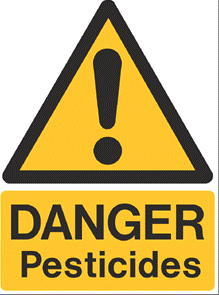
Aside from the poor quality and uniform taste, when parents use commercial baby food, they’re also giving their baby a varied diet – of contaminants. Recently, scientists at the Environmental Working Group (EWG) tested 190 samples of commercial baby food. The samples tested positive for five pesticides, among them, the organophosphate methamidiphos, which was found on 9.4 percent of samples and the organophosphate acephate, on 7.8 percent of samples. Based on the scientists’ calculations, a 22-pound child eating just one four-ounce serving of green beans sold as baby food with the maximum methamidiphos level found would consume a massive 50 percent of the U.S. Environmental Protection Agency’s acute risk value, a measure of allowable risk. Lighter babies, those fed more than four ounces per meal or those fed commercial baby food daily would be at still greater risk (EWC 2012).
The EWG also analyzed baby food samples back in 1995 and found the two organophosphates in surprisingly similar concentrations. So nothing has changed. The illusion that baby food manufacturers are continuously improving their products to make them safer for babies, is mere wishful thinking unincentivised by legislation.
In the 2012 study, pears prepared as commercial baby food showed significant and widespread contamination. 92 percent of the pear samples tested positive for at least one pesticide residue. Some 26 percent of the samples were tainted with 5 or more pesticides. Disturbingly, the pesticide iprodione, which EPA has categorized as a probable human carcinogen (cancer causing agent), was detected on three baby food pear samples. Iprodione is not registered with EPA for use on pears. Its presence on this popular baby food constitutes a violation of FDA regulations and the federal Food, Drug, and Cosmetic Act.
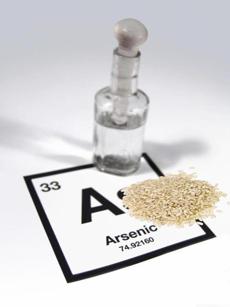
Other research has shown that feeding babies twice a day on commercial baby foods such as rice porridge can increase their exposure to arsenic by up to 50 times! (Gray 2011; The Local 2013). In the same studies, exposure to other toxic metals such as cadmium, which is known to cause neurological and kidney damage, increased by up to 150 times! While lead increased by up to eight times.
A quick nod to so-called ‘baby ready meals’ now. These are frozen or chilled processed meals that you re-heat yourself. One of the many problems with these is that they consistently contain heat-induced contaminant ‘furan’, a toxic compound linked to cancer (Bakhiya and Appel 2010; Lachenmeier 2009).
On the topic of cancer, many commercial baby foods, particularly jarred varieties, contain benzene, a colorless, flammable liquid with a sweet odor. It is also a natural part of crude oil, gasoline, and cigarette smoke. Benzene is known to cause cancer, based on evidence from studies in both people and laboratory animals. The link between benzene and cancer has largely focused on leukemia and cancers of other blood cells (American Cancer Society 2013). In one study, the highest levels were found in jarred baby foods containing carrots and carrot juices specifically intended for infants. In contrast, freshly home-prepared carrot juices and baby foods were all benzene-free (Lachenmeier et al 2010).
The cancer link doesn’t end there. All types of processed baby food, whether jarred, frozen or pouched, have a significant likelihood of being contaminated with fumonisin – a toxin linked to esophageal cancer (Sedova and Tutel 2006), Cadmium – an extremely toxic metal (Eklund and Oskarsson 1999), and noxious animal DNA which has been linked to diabetes and various types of cancer (Surh et al 2007). Recently, the latest cancer-causing chemical to join the party – Acrylamide – a toxic chemical compound has been found in commercial baby foods, cereals and potato chips (FSA 2013).
Exposure to such toxins in infancy can cause problems that will wreak havoc for the rest of a child’s life. This is because babies’ bodies are different. They are growing and vulnerable. It’s important to know what’s in the foods you’re feeding your baby at this age. But you won’t find out this information from the baby food manufacturers. When a leading UK newspaper recently contacted each of the major baby food manufacturers, most refused to reveal the levels of toxic contaminants found in their products! (The Telegraph 2011).
THE REGULATION (lack of):

One of the reasons that contaminants are still rife in commercial baby foods is due to weak legislation. Leading baby food manufacturers such as Heinz, Gerber, and Cow and Gate do not face as tough regulations as the makers of adult foods (University of Greenwich 2012). The current maximum limits enshrined in law are not low enough to act as an incentive for baby food manufacturers to cut levels of the contaminants in their products (Pesticide and Chemical Policy 2013). Even when baby food manufacturers stick within the legal guidelines for permitted levels of toxic contaminants, there’s a major problem – the guidelines are based on adult, rather than infant, exposure. Adult tolerance levels are much higher than infants’. Babies are particularly vulnerable to toxic substances because their immune systems are immature and their bodies are going through rapid development. A five year study by the National Academy of Sciences has concluded that Government standards for pesticides in food do not specifically account for the special vulnerability of infants or account for the fact that infants and children eat and drink more relative to their size than adults.
Unsurprisingly, more and more research is calling for a radical review of the safety limits. So much so, that the World Health Organisation decided to scrap its daily safe intake limit for arsenic amid growing evidence that arsenic can cause cancer – even at low levels (World Health Organisation 2010). The limits for lead have also been suspended for the same reason.
Sadly, the failure of legislation to protect babies stretches through many other areas of baby food regulation. Take labelling for example. What’s in the container is not always the same as what’s printed on the label. Some ingredients are not mentioned, for example, sweeteners and trans fat. At present, regulations require just 15% of the reference values for each nutrient to be provided for labeling purposes.
The situation becomes even more acute when potential allergens are present in the food. A lot of baby food manufacturing plants also process allergens such as nuts, dairy and soya. To address this, there is a legal threshold of how much of an allergen has to be in a food product in order for it to be required to be labelled. Sounds good right? However this threshold is based on general adult tolerance levels which are irrelevant to babies.
THE WASTE:
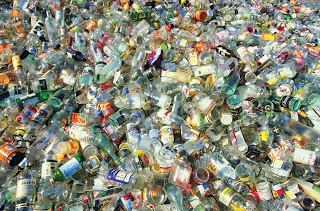
Commercial baby food is commonly packed in glass jars. However new demands for convenience have given away to trends involving plastic, sealed containers and pouches. Valuable natural resources are needed to manufacturer these items. Eventually all this packaging ends up dumped in landfill.
There is also the pertinent issue of food waste. Initially babies will take only one or two spoonfuls per meal, yet the jars are far, far bigger. As they can’t be re-sealed, the remaining contents must be disposed of. Alternatively, parents eager to get their money’s worth over-feed their babies, stretching their stomachs and contributing to future weight problems.
THE PACKAGING:
Aside from the waste element, the packaging of commercial baby food has been found to be dangerous in itself. For instance, several studies have found the lids of baby food jars contain the hormone disrupter Bisphenol-A (BPA) which has been linked to infertility and cancer, even at extremely low levels of exposure (Health Canada 2009). BPA leaches from the baby food containers into their contents.
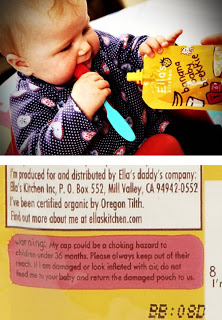
When this was announced in the press, a few manufacturers changed their packaging, opting to use a substitute (bisphenol S). Many ceased this as a marketing opportunity, boasting “BPA-free” on their packaging. However unbeknown to consumers, bisphenol S also disrupts hormone activity. In fact, it is a stronger risk to babies than BPA (Medical Express 2013).
Commercial baby food packaging is also responsible for exposing babies to a carcinogenic toxin called semicarbazide (SEM). The toxin, which has been linked to cancer in animals, gets into the baby food through the plastic gaskets used to seal glass jars with metal twist-off lids (Roberts 2009).
Another area of concern is the transfer of mineral oil saturated hydrocarbons (MOSH) from recycled packages. Many different typews of MOSH chemicals are used by the baby food industry either directly or indirectly, and many foods become contaminated with them. These chemicals are easily absorbed by the body but are not broken down. They can accumulate in certain organs, such as the liver, heart and lymph nodes, and may cause them to become damaged or diseased (Probert 2013). A recent study of commercial baby foods found MOSH in all of the samples tested (Mondello et al 2012).
Pouches are also not without their risks. The caps pose a serious choking hazard to babies and toddlers (the product’s target age range).
THE MARKETING:
All the defects inherent in commercial baby food discussed mean that persuading parents to purchase these products is not easy. However the baby food companies have literally millions of dollars to pay marketing executives to execute sophisticated deception techniques.
A key strategy in baby food marketing is to utilise the latest buzz words. When the new food guide pyramid touted the importance of whole grains for example, suddenly words and logos for “whole grains” were plastered on the fronts of baby cereal boxes, crackers, breads and even cookies! Now with the media’s attention on the potentially harmful nature of genetically modified ingredients, many baby food manufacturers are re-marketing themselves as ‘organic’. No matter what the fad is—low-sugar, fat-free, organic, or heart-healthy—manufacturers will try to lure parents into buying their product.
Here’s a list of the most popular baby food marketing claims used by manufacturers—and what they really mean for your baby’s health.
“Natural”
Ironically, products that call themselves natural can contain pesticides, genetically modified ingredients, high-fructose corn syrup (HFCS), or ingredients you’ve never heard of. The Food and Drug Administration says that it has not developed a formal definition for the term, noting that, “From a food science perspective, it is difficult to define a food product that is ‘natural’ because the food has probably been processed and is no longer the product of the earth.” The agency goes on to explain that added color, artificial flavors or synthetic substances would disqualify food from being called “natural.” But beyond that, seemingly anything goes. A company can use the word to mean just about anything. Parents often assume it implies ‘organic’, but that’s not the case. Whilst ‘natural’ brings to mind thoughts of fresh, minimally processed and healthy food, it indicates nothing about a food’s nutritional content, ingredients, safety, or health effects (Jolliffe 2011). According to the USDA, food is natural if it doesn’t contain artificial ingredients or added color and is ‘minimally processed.’ It doesn’t say anything about how the food was raised. Almost all packaged foods today are processed in some way.
Also consider that ‘natural’ is not always synonymous with ‘healthy’. Natural fruit puree may be sweetened with cane juice (instead of white sugar), but it can still contribute to health issues when eaten regularly. Quaker Oats boast that their children’s range of cereals are 100% natural however they contain 13.7g of sugar per 100g!
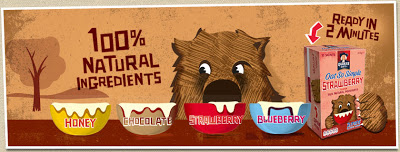
“Made with Real Vegetables”
You see “made with real vegetables” frequently on baby food marketing, particularly those products advertised as ‘organic’. Since there is no law that requires how much real vegetable has to be included in a food that uses this claim, the jar could contain just a few peas or one brussel sprout to be accurate. Also ‘baby grade vegetables’ (i.e. scraps) are still ‘real vegetables’, albeit not ones that adults are prepared to consume.
“Healthy”
While food claimed as ‘healthy’ must meet specific guidelines for fat, cholesterol, sodium, and certain nutrients, it can still contain large amounts of sugar, preservatives, and artificial ingredients.
“Lightly Sweetened”
This term is not regulated by the FDA, so the product could contain any amount of sugar or artificial sweeteners.
“Green”

Green is not regulated and has no real meaning as it relates to food and often seems to be used in an effort to convey some sense of sustainability or environmental responsibility, whether that’s real or not.
“Made with whole wheat”
If the label does not say 100 percent whole wheat or 100 percent whole grain, then be wary: the product is likely to contain only a trivial amount of whole grain.
“Multigrain”
According to the USDA, the only label that means a product is made with 100% whole grains is one that states “100% Whole Grain”. Products with labels declaring “multigrain” simply means that there are multiple types of grains, but that is not a guarantee that any of the grains included are whole grains. For example, Heinz Baby ‘Banana Multigrain Cereal’ contains hydrolysed wheat and no whole grains.
“A source of”
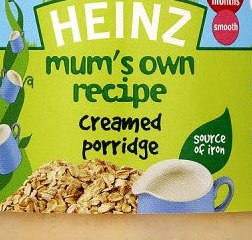
This is a purposely vague, loose term that insinuates that the food contains the latest sought-after vitamin or mineral. The recent trend is a lack of Vitamin D, because of concerns that a deficiency in Vitamin D may play a role in autism. If a food says it is an “excellent source of Vitamin D,” it may only mean: As a part of a normal diet, in which you get vitamins and minerals, this food will provide a minute amount of Vitamin D. For instance, Heinz “Creamed Porridge” declares prominently on the front of the label that it is a ‘source of iron’, however one serving only contains 1mg of iron. A baby’s recommended daily allowance is 11mg!
“Simple”
This is a very popular buzzword used in the contemporary food industry to suggest the product is just like homemade food (which obviously it’s not because it’s a processed food). “Simple” foods are packaged in boxes, pouches and jars with uncluttered design and, often, cursive logos and a lot of green. Organix Ltd are a prime example. They market their Apple And Blueberry puree as ‘simple and smooth’. However look at the label. Things aren’t really that simple. The product contains several ingredients including Ascorbic Acid. Likewise, Gerber ‘simply peach’ yogurt contains 13 separate ingredients! – including Tapioca Starch, Gelatin, and Citric Acid. It even contains more added sugar than it does peaches (quite rich for a product called ‘simply peach’!)
Unfortunately, ‘simple’ is becoming a highly saturated word in the baby food sector. Let’s play a game of Spot the Simple!
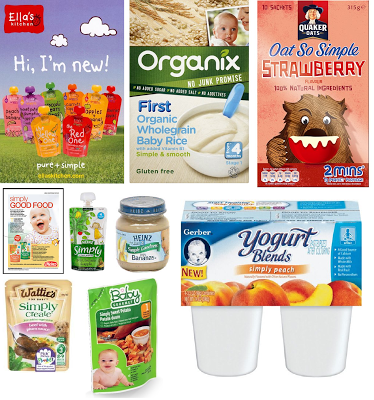
“Hearty”
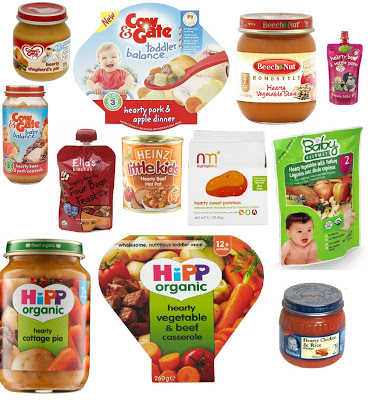
“No Added Sugar”
A product can say ‘no added sugar’ on the front of the packet, and still contain enough fruit syrup to take the total sugar level to over 50% of the product by weight. In fact, fifty three percent of food products specifically targeted to babies and toddlers have an excessive proportion – more than 20 per cent – of calories coming from sugar (Science Daily 2010). Yet dietary recommendations suggest that sugar should not contribute more than 10% of energy.
“No Added Salt”

In a similar vein to the ‘no added sugar’ claim, when a product claims to have ‘no added salt’ it can still ironically be high in salt. For example, when you a buy a meal containing cheese, it is allowed to say on the packet “no added salt” when in fact the meal contains a significant amount of salt, which is contained in the cheese itself. A 100g of cheese can contain 1.5g to 3.5g of salt (more than a child’s recommended daily intake). Also, a lot of manufacturers use the word “Sodium” on their nutritional information label instead of salt because this enables them to disguise the true salt content of the product (Hint: to convert sodium levels per 100g into salt, multiply the figure by 2.5).
“No Artificial Sweeteners”
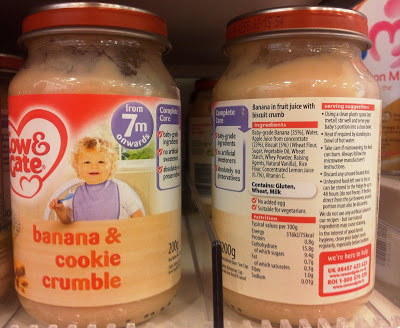
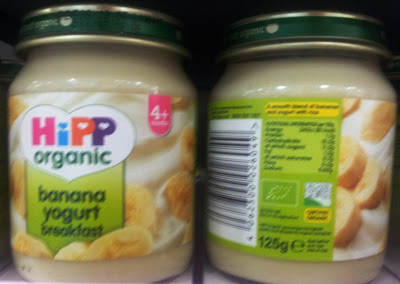
“No Artificial Preservatives”
Alongside boiling the food to death, part of the strategy used by manufacturers to increase shelf life is to add natural acid, which acts as a preservative (Koufman 2010), and because it’s ‘natural’ it enables the company to flaunt the ‘no artificial preservatives’ buzzwords. Organic brands are particularly fond of this technique as it allows them to add a preservative whilst at the same time retaining their 100% organic claim. Acids commonly added to these foods include citric acid, ascorbic acid and even folic acid. Citric acid is commonly used to remove limescale from boilers and evaporators. Ascorbic acid is used to remove dissolved metal stains, such as iron, from fiberglass swimming pool surfaces. When added to food, these acids increase the acidity in your baby’s diet and thus result in increased incidents of baby reflux.
Heinz ‘Banana Delight’ contains just 16% banana! The label touts the claim “absolutely no artificial colours, flavours or preservatives” in large bold font on the front. The product contains citric acid as a preservative and added sugar, which also acts as a preservative. Both of these ingredients erode babies’ teeth as well as triggering reflux and increasing other health risks.
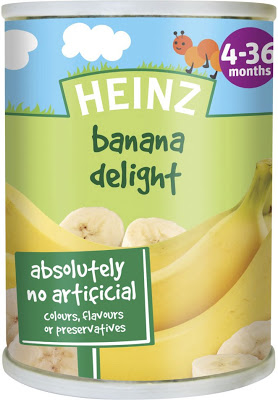
“No Artificial Flavours”
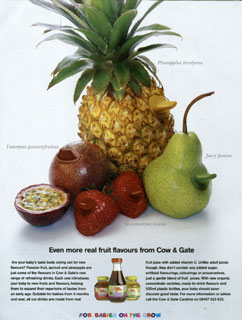
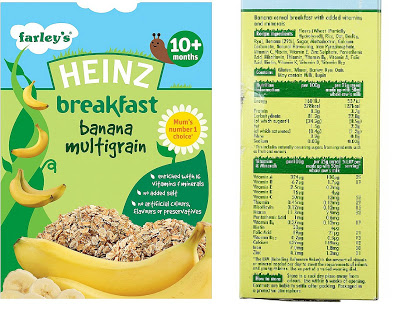
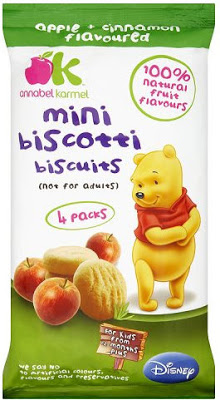
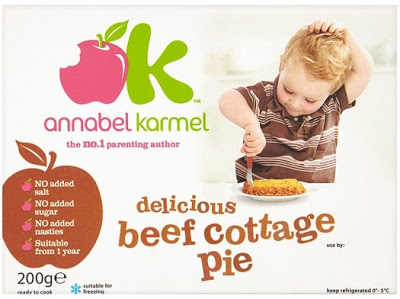
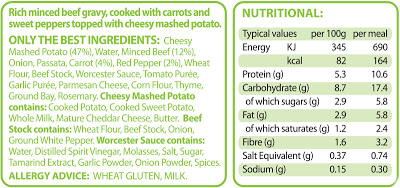
In a nutshell, health claims such as those discussed above act as a marketing smokescreen. In their study, the Children’s Food Campaign discovered that almost all the baby food products found to contain high levels of sugar and/or saturated fat also carry health claims such as “Added vitamins”, “No added salt” or “No added preservatives”. While such claims may be factually true, they are simply a ploy to distract parents’ attention from less healthy attributes of the product. This gives a misleading impression of the overall healthiness of a product, making it more difficult for parents to choose healthy products.
In 2006, legislation was introduced (Regulation (EC) 1924/2006) to ensure that health claims cannot be made about less healthy products so that consumers are not misled and can make informed choices. However baby foods are excluded from this legislation because babies and young children have different nutritional requirements than adults. Yet no comparative regulation was introduced for babies!
THE ‘ADDITIONAL’ INGREDIENTS:
As well as everything the manufacturers planned to include in the product, there is a significant risk of unplanned ingredients slipping in during the industrial process. Due to the nature of manufacturing – the sheer quantity of product produced, the capacity for corrupt employees, lengthy transportation and packaging chains – foreign objects are par for the course.
Here’s a timeline detailing the recent history of undesirable (to put it mildly!) objects found in commercial baby food.
2004:


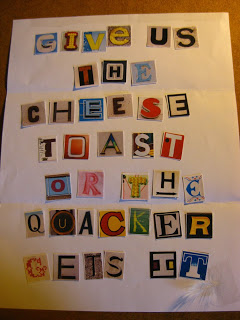
2006:

2008:

2010:



2011:



2012:
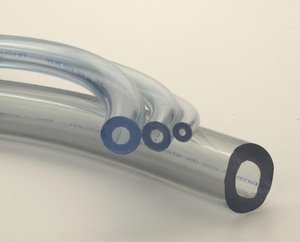

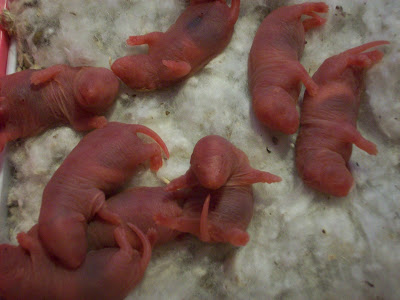
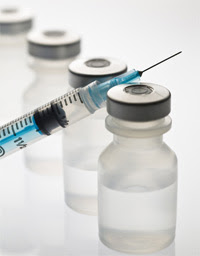
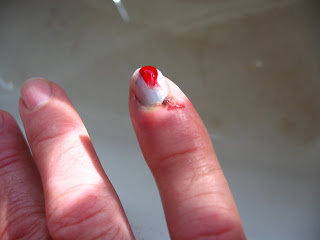
2013:

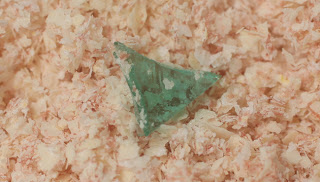

2014:
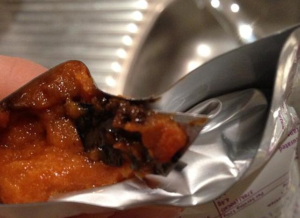
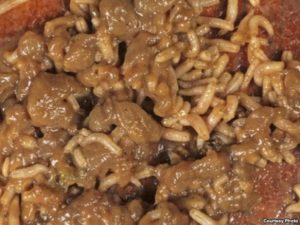

For instance, tomato paste, pizza sauce or other sauces can legally include 30 or more fly eggs per 100 grams. Alternatively, you can have 15 or more fly eggs and one or more maggots. As another example, wheat flour, a common ingredient in baby food, can include an average of 150 or more insect fragments per 100 grams! (FDA 2011). Bon appetit!
To Conclude
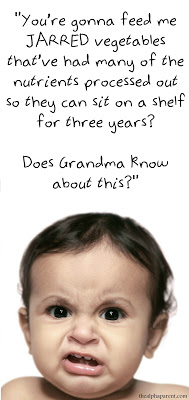
It is a child’s birthright to be provided with healthy and wholesome food to aid their optimum growth and development. Yet parents who assume that the food industry share this view are naive wishful thinkers. Jarred baby foods exploit parents’ trust in terms of cost, value, nutrition, quality and safety. Pouched, potted and boxed baby foods are not immune either.
Reliance on baby food manufacturers to show social responsibility is ineffective because companies are legally obliged to act the best interest of their shareholders, not consumers. Asking baby food manufacturers to change merely serves as a distraction from perusing more effective initiatives. For instance, there is an urgent need for adequate Government regulation of the baby food industry. There’s no need to vainly rely on manufacturers’ good will when Government has the power to enforce effective regulation.
In the meantime, what’s the best way to improve the nutritional value of your baby’s foods? The answer is surprisingly simple! Just puree the vegetables and fruits or meats in a blender yourself and store them overnight in the refrigerator. Ta-dah! Or hell, why not go the easy, and frankly common sense route – baby led weaning.











